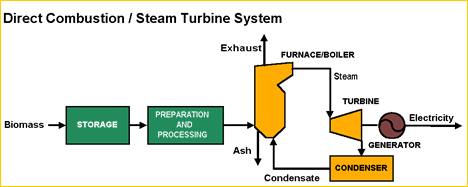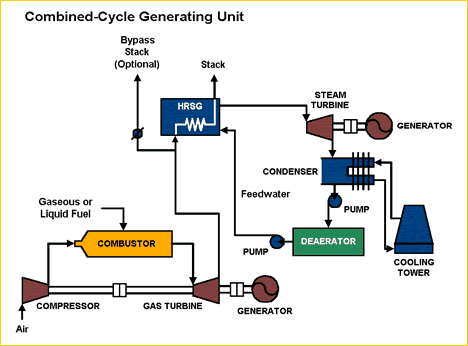



Technologies - Gasification
Power Cycle Options
Gasification and production of a clean fuel gas makes a wide array of power options possible, including the use of advanced power systems with higher efficiencies than those obtained from steam turbines. At the low cost end of the spectrum, gasifiers coupled to a high-efficiency, simple-cycle gas turbine offer simplicity as well as efficiencies competitive with the Rankine cycle.
Following the trend established by both coal and natural gas for large scale plants, combined gas and steam cycles along with their variants (e.g., Steam Injection Gas Turbine (STIG) and humid air turbine (HAT) offer power cycle efficiencies approaching 50% (6800 Btu/kWh). Looking slightly further into the future, fuel cells could offer efficiencies in this range, and could possibly push the ceiling even higher.

- High-Efficiency
Simple Cycle Gas Turbines
- Combined
Gas and Steam Cycle Plants
- Steam-Injected
Gas Turbines
- Fuel Cells
*All gas turbine efficiencies on this and linked pages are based on operation with natural gas, unless otherwise noted.
High-Efficiency Simple Cycle Gas Turbines

Traditionally, poor part-load efficiency has limited the use of the simple cycle gas turbines to peak-load power generation. More recently, some turbine manufacturers have developed high-efficiency gas turbines that do not have to utilize the high-temperature exhaust gases to boost efficiencies. Superior clearance control and advanced compressor and turbine blade design have allowed simple cycle gas turbines to reach power cycle efficiencies approaching 36% (9,500 Btu/kWh) (United Technologies 1991). A fluidized-bed biomass gasifier (which does not necessarily require steam) integrated with a high-efficiency gas turbine may be the best combination for simple cycle operation.
Combined Gas and Steam Cycle Plants

Natural gas-fired combined cycle plants are currently making inroads into the utility grid for intermediate and base load operation. These plants have efficiencies approaching 50% (6,800 Btu/kWh) and usually exceed 600 MWe in output. The combined cycle technology is commercially available and can be expected to improve as turbine manufacturers compete for improved efficiency, NOx control, and availability.

The steam-injected gas turbine is an adaptation of the combined cycle in which the exhaust gases from the turbine are used to generate steam in a heat recovery steam generator (HRSG). This technology offers flexibility for electricity/steam cogeneration applications. When process steam demand falls, the steam from the HRSG can be injected into the combustor and/or the turbine sections of the gas turbine. The steam which is injected into the turbine is additional mass which is used to help drive the turbine and which does not consume power at the turbine's compressor. Furthermore, because the specific heat of the steam/air mixture in the turbine is twice that of air alone, more power can be extracted in the turbine section when using steam injection. Adding steam in the combustion zone of the turbine lowers both the flame and gas temperatures and prevents up to 80% of uncontrolled NOx formation (Makansi 1989).
The addition of compressor intercooling to the STIG cycle (intercooled STIG or ISTIG) can raise both thermal efficiency and shaft power output. The ISTIG can double the output of a simple cycle gas turbine, while pushing its overall power cycle efficiency above 50% (6,800 Btu/kWh) (Makansi 1989).
Fuel cells convert the energy of electrochemical oxidation of a fuel into electricity. Typically, gaseous fuels are fed continuously to the fuel cell's negative electrode (anode), while an oxidant such as oxygen or air is fed continuously to the positive electrode (cathode). The electrochemical reactions produce electrochemical potential (voltage) and electric current in a manner analogous to that of a battery. A variety of fuel cells are in development, but three types are considered by electric utilities to be the primary candidates for near-term commercialization. These are the phosphoric acid fuel cell (PAFC), the molten carbonate fuel cell (MCFC), and the solid oxide fuel cell (SOFC).
PAFCs are considered the closest to commercialization, with systems having been field tested up to 11 MWe. They operate at about 200°C (390°F), with power cycle efficiency potential as high as 45% (7,600 Btu/kWh). While PAFCs are clearly in the lead in terms of developmental status, they have some disadvantages in comparison to other fuel cell technologies. The most significant is that PAFCs require external fuel processing (reforming) capabilities, lowering the efficiency and increasing plant footprint and cost.
The MCFC operates at 650°C (1,200°F) with maximum power cycle efficiencies approaching 60% (5,700 Btu/kWh), and is internally reforming. The simpler design results in expectations that the MCFC should be more reliable and less costly in the long run. One primary concern with the MCFC technology is that the electrolyte is highly corrosive and may compromise system life. The ability of the MCFC to convert more of the gas constituents (CO and methane in addition to H2) in the process makes it more suitable for power generation utilizing low-H2 fuels such as biomass-derived gas. While the suitability of biomass gas as a fuel for the MCFC needs more investigation, the success of coal gas as a fuel bodes well for biomass gases with similar composition.
A non-corrosive solid-state zirconium oxide ceramic material is used as the electrolyte in the SOFC. In addition to providing a possible solution to the corrosion problems the SOFC operates at a much higher temperature (1,000°C/1,800°F), giving it the capability to produce high-temperature steam for cogeneration applications. It is the least well-developed of the three technologies being considered by electric utilities.